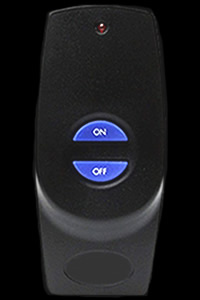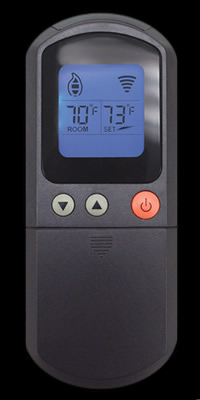Gas Control Types: Manual | Millivolt | Thermostatic | Variable
Manual Control

Manual control is just that; manual. You turn the burners on, and can adjust the flame height by a control knob on the gas appliance. This adjusting ability is usually very desirable in a vented log, because the action of a vented log is wider and has more of a range of flame height to adjust. On a vent free appliance, you manually adjust the flame height in order to control temperature in the room. Manual control appliances are not capable of using a remote control or wall thermostat and cannot be retro-fitted.
PROS: Least expensive. Adjustable flame.
CONS: Cannot use remote control or wall thermostat. Cannot be modified to be made millivolt (or remote-ready).
Millivolt Control

Millivolt control has a control valve that allows for the use of a remote control, a wired or wireless wall thermostat or a simple on/off switch. Because they offer this level of functionality, they are more expensive. Use of a wall-mounted or hand held thermostat cycles the gas on and off, in order to maintain temperature. This is a very popular control system for logs while not being too expensive and offering good accessibility to accessories and options. Flame height is adjusted by turning a knob on the gas appliance, so they can also be used manually. Millivolt (or remote-ready) offers the most overall flexibility as more different types of remote units and switches are available than for any other gas system.
PROS: Can use a variety or remote-type control systems or can be used manually. Most number of different control systems available.
CONS: Cannot adjust flame height via a hand held remote or wall switch. Slightly more expensive than manual control.
Thermostatic Control

Thermostatic control units offer automatic temperature control. They utilize a modulating hydraulic gas valve to maintain room temperature via a heat sensing capillary. Operation is quite easy. Simply light the pilot, turn the flame up to HIGH until the room is comfortable, then turn slowly turn the knob towards LO until the the flame cuts off. The control is now set and the valve will "modulate" the flame on and off to maintain the temperature you chose. Very simple to use. However, you cannot adjust flame height with this system. To override the system, you must turn the knob fully on HIGH and leave it there. Thermostatic controlled heaters and fireplaces allow temperature setting on the unit, and the fireplace or heater will cycle on and offer to maintain temperature in a room. This can be also be achieved with a millivolt system with some type of thermostat remote.
PROS: Allows modulating control over temperature in the room. Extremely easy to use.
CONS: Slightly more expensive than manual control. Capillary sensor is usually visible in the room. Does not allow for manual control with adjustable flame height.
Variable Control

Variable, aka Hi/Lo control offers flame height control by remote only. You systematically depress and release the "on/hi" switch on a hand held remote (or remote receiver box) until the flame reaches the desired height. If you want to turn the log set off, you depress and release the "off/lo" switch until the flame turns off. You cannot easily control the log set manually, but it can be done. It does, however, allow flame height control via remote.
PROS: Flame height control by remote control.
CONS: More expensive than millivolt control. You must keep fresh batteries available for the remote since all control is powered by battery. Fewer control options than with millivolt.